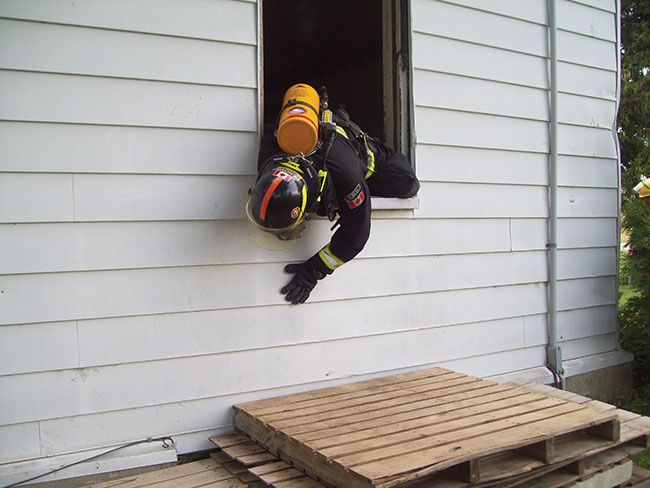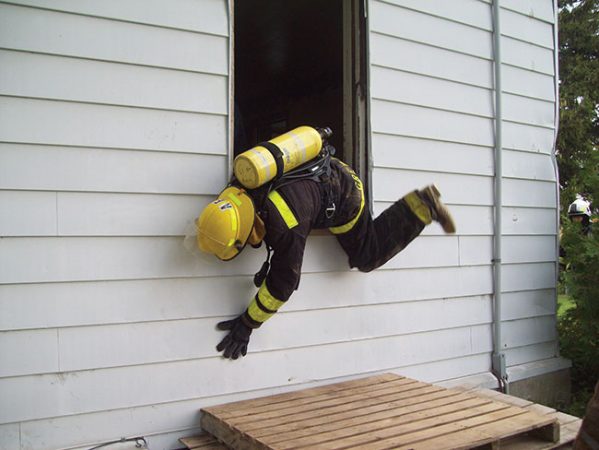
Back to Basics: Firefighter survival — windows
By Mark van der Feyst
Features Once the window has been cleared, the firefighter will start to position themselves onto the sill going head first out the window.
Photo credit: Mark van der Feyst.
Once the window has been cleared, the firefighter will start to position themselves onto the sill going head first out the window.
Photo credit: Mark van der Feyst. Every residential structure that we enter will have common features that we can count on when it comes time to firefighter survival and self-rescue. One of these common features are windows – every residential structure will have them. Windows are designed to provide natural light into the building, allow for natural ventilation for the structure, and are designed to make the structure look aesthetically pleasing to the eye.
Windows are also put in place as a way for escape for the residential occupants. Whenever we conduct a public education session and are teaching children about ways to escape their home, we include using the window. If the bedroom is on the second story, have an escape ladder in the bedroom so that the child can climb out the window and down to the ground. Windows are an escape avenue for the occupants, and they can also be used for the firefighter.
With respect to firefighter survival, a window can provide four different options for self-rescue: low window roll/straddle, hang and drop, head-first ladder dive and rope slide or rope bailout. All of these options are useful and have a place in firefighter self-rescue and have proven themselves to be so from past events, and from firefighters who have survived by using one of these options.
In order for any of these options to work, there is one key element that needs to be done each and every time – the window needs to be cleared. This will involve using a hand tool of choice to break the glass and then clear the glass out as much as possible to remove any obstructions that may hinder getting out. Sharp glass will cut through firefighter gear easily and in the face of death, receiving an open wound from cut glass is better than dying, however, we want to avoid that as well because that can be just as fatal.
If the window was already cleared and taken out by exterior crews, then there will be one less step to worry about for the firefighter. This may be the case if there was an order to take out a window for ventilation operations or if the fire self-vented from that window. Proactive RIT teams or exterior crews listening to the radio and hearing the mayday call, may take quick action to take out a window to provide an escape opening for the interior firefighter who may be right there.

The firefighter is almost all the way out of the building and in mid roll, with the last body parts to leave being the legs.
Some of the four options listed above are applicable to second story or higher residential structures, while the low window roll or straddle are useful for single story structures only. Of the four options, the low window roll or straddle is the least risk involved when executing.
The majority of windows are going to be about three feet up from the floor, depending upon the age of the home. In older homes that are a century old, the windows may be lower than three feet, which will aid in the execution of the escape. On the inside of the structure, you may find pieces of furniture or other items in front of the window. These can be easily moved out of the way or just go over top of them when getting out.
On the outside of the structure, below the window, may be a few items that may harm us such as decorative garden items, landscaping rocks, etc. The distance from the windowsill to the ground will vary based upon the topography of the land. We cannot assume that the ground will be at the same level as the floor on the inside. It may drop down quite a few feet, or it may not.
Once the window has been cleared, the firefighter will start to position themselves onto the sill. They will want to lead with their head first out the window as seen in Photo 1. Notice at this point the firefighter’s body is halfway out of the window. By leading with the head first, the firefighter will be able to see what they are going to be encountering on the outside. Their one hand can be used to help brace themselves or control their fall against the exterior wall.
The other hand that is inside the structure can be used to hold themselves from completely rolling out, sort of like a brake. If they need to stop what they are doing and just straddle the windowsill, they can do so at this point. In Photo 1, you will see how low the firefighter is in the window compared to the height of the window. We are needing to stay low so that the heat that is venting out will not be cooking us when trying to get out. Remember the window is now a vented opening and is considered a flow path as there will be either a uni-directional or bi-directional flow path occurring. Hopefully the window will be a bi-directional flow path providing cooler air on the bottom.
In Photo 2 you will see the firefighter is almost all the way out of the building and in mid roll. The last body parts to come out are going to be the legs. As the firefighter leads with their head, they are going to point themselves toward the ground slightly so as to use gravity to aid with the roll. Where the head goes the body will follow, and in this case, the legs and feet will roll out with the rest of the body.
Once the firefighter is committed to rolling out, they will tuck and roll out of the window and land on the ground. This will not be a “pretty” picture or a textbook landing because the firefighter is getting out of the building quickly to escape certain demise. The firefighter may sustain injury due to the landing because they are wearing their SCBA and that may hit the ground first, then the body will land on top of the SCBA.
Once out of the building, the firefighter will need to be looked at by EMS and may need to be transported to hospital as a precaution. In upcoming editions we will look at the remaining three options of using a window to escape.
Mark van der Feyst has been in the fire service since 1999 and is currently a firefighter with the FGFD. Mark is an international instructor teaching in Canada, the United States, FDIC and India. He is the lead Author of Fire Engineering’s Residential Fire Rescue book. He can be contacted at Mark@FireStarTraining.com.
Print this page